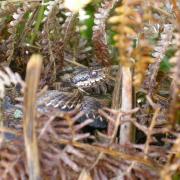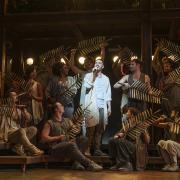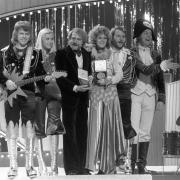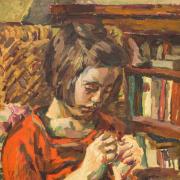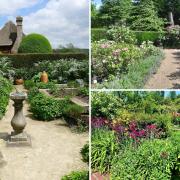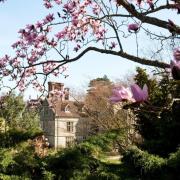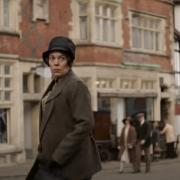Solution for the ‘Master of Line’ piece by Tony Ward in the Sussex Life February issue
• January solution• December solution
Who is it? ‘Master of Line’
Artist and Aesthete,
A Master of Line.
Subverting, provoking,
ahead of his time.
.
Brighton born and Brighton schooled,
his love of books and music,
his mother’s inspiration.
.
Pacing the seafront, learning lines,
penning poems, drawing, drawing.
Mischievous sketches of teachers and friends.
A wicked wit. A sign of things to come.
.
The Brotherhood, inspired, advised,
from office clerk to School of Art.
Parisian posters, woodblock prints,
visions that seized his pen,
that set his mind on fire.
.
Elegant lines, but dark images,
grotesque, bizarre, erotic,
the cavern of his soul.
.
Classic tales, licentious illustrations,
Morte d’Arthur, Salome, Lysistrata …
first commission, public scandal, private passion.
.
Art Nouveau, new art for a new age.
Death of an artist, death of his Queen.
A white plaque on a house,
a spirit in the air,
one who added to life,
but died at the age of a flower.
Solution – Aubrey Vincent Beardsley (1872 – 1898) – an influential but controversial illustrator.
Explanation of embedded clues
Aubrey Beardsley was a talented, innovative, artist and illustrator but “subverting, provoking, ahead of his time”. He scandalised large sections of Victorian society with his “grotesque, bizarre, erotic” illustrations of works based in particular on historical and classical mythology. The Times described his drawings as ‘unintelligible for the most part and, so long as they are unintelligible, repulsive’. His friend Oscar Wilde described them as works of genius emerging from ‘the cavern of his soul’. One of his much-quoted maxims was ‘I have one aim – the grotesque. If I am not grotesque I am nothing’.
His drawings in black ink displayed his undoubted “Mastery of Line” but the portrayal of his subject matter was frequently disturbing and at the time often considered obscene. They were “Elegant lines but dark images”. Female emancipation was some way off. As Maria Popova writes in an article concerning Beardsley’s illustrations for Oscar Wilde’s play Salome, ‘Beardsley’s intensely erotic drawings subverted the era’s gender norms by portraying women as sexually empowered, even predatory, rather than the docile and demure creatures Victorian society expected them to be’. In our day the artist Tracy Emin has pushed the boundaries far beyond those breached by Aubrey Beardsley, but the effect would have been similar.
Having said all this, Beardsley was a major contributor to the development of “Art Nouveau, new art for a new age”. He forever changed the course of the graphic arts. Out of what he labelled ‘grotesque’ has come something beautiful and valuable, in monetary as well as aesthetic terms! The ‘Aesthetic movement’ was in fact the label attached to the movement in which Beardsley was a leading figure.
Brigid Brophy in Black and White: A portrait of Aubrey Beardsley (1968) writes that ‘Beardsley is lyrical by virtue of his gift of line, which resembles the gift of melodic invention. Beardsley’s lines, like great tunes go up and down in beautiful places … A Beardsley sequence is like a sonnet sequence’.
The second and third verses are concerned with his Brighton connection. He was born in Buckingham Road, in his parents’ house on the corner with West Hill Place. The house is now numbered 31, although it was originally number 12. There is a white plaque on the house. The poem title, “Master of Line”, was taken from the words on the plaque.
Later, at the time that he started at the Brighton, Hove and Sussex Grammar School, aged twelve, he was living with his great-aunt Sarah at 21 Lower Rock Gardens. The Grammar School building, in Buckingham Road, later became the Sussex Maternity Hospital.
Prior to his grammar school years (1884-1888) his mother had inspired in him and his sister, Mabel, a love of books and music. Beardsley was something of a musical prodigy. The year before he started at Brighton Grammar School the family was living in London, where Beardsley gave several public concerts playing Bach and Beethoven.
While at the Grammar School he took part in dramatic productions. Kate Elms, Brighton History Centre, writes that the young Beardsley was to be seen “pacing up and down on the seafront, learning his lines”. He also wrote dialogue, designed costumes and illustrated the programmes. His main contribution though was to the school magazine, Past and Present, to which he submitted poems and drawings. There were also “Mischievous sketches of teachers and friends. / A wicked wit. A sign of things to come”.
From School he went to work first in an architect’s office and then as an office clerk with an insurance company. In Rottingdean though he had visited Sir Edward Burne-Jones who advised him to change direction and attend classes at Westminster School of Art. This he did in 1892, at the age of 20. He also took inspiration from another member of The Pre-Raphaelite Brotherhood, Dante Gabriel Rossetti. From Art School to Paris, where he encountered the poster art of Henri de Toulouse-Lautrec and the simple but effective fine black lines of Japanese woodblock prints, fashionable at the time. He forged these elements into his own highly personalised style.
His first significant commission was to illustrate a new edition of Le Morte d’Arthur by Sir Thomas Malory. It was issued in twelve parts between June 1893 and mid-1984. His publisher, J. M. Dent, liked his illustrations, but although a modest success at the time it did not become a best-seller. It is however now regarded as Beardsley’s first masterpiece, containing over 500 illustrations.
Beardsley composed a little limerick in mock protest at his publisher’s demands:
There was a young man with a salary,
Who had to do drawings for Malory;
When they asked him for more,
He replied, ‘Why? Sure
You’ve enough as it is for a gallery.
(As quoted in Aubrey Beardsley: A Biography (1999) by Matthew Sturgis, p. 155)
Beardsley’s second major work was a set of drawings for Oscar Wilde’s play Salome, which Wilde wrote in February 1892. The play was a racy interpretation of the biblical story. After some controversy the play was eventually premiered in Paris, but when Wilde tried to get it produced in London, with Sarah Bernhardt in the lead role, it was banned by the Lord Chamberlain as being blasphemous.
The play was subsequently published in an illustrated book form. Wilde was familiar with Beardsley’s work and at his publisher’s suggestion Beardsley was asked to provide the illustrations. Beardsley’s drawings were no less shocking than the text. His publisher, John Lane, rejected one drawing as indecent and Beardsley also substituted three more – ‘simply beautiful and quite irrelevant’. The illustrated Salome, published in February 1894, caused a “public scandal”. Perhaps because of this the book sold well. Beardsley was able to use the resulting income to lease a four-storey house in Pimlico.
A parallel could be drawn with the publication of D. H. Lawrence’s, Lady Chatterley’s Lover (1928) in an unexpurgated paperback edition by Penguin in 1960. Penguin was charged under the Obscene Publications Act 1959 of publishing a book that had a ‘tendency to deprave and corrupt’. Following a widely-reported trial at The Old Bailey that year, Penguin were found ‘not guilty’ by the jury. It was a landmark case. The book flew off the shelves.
For Beardsley, there followed a short time as co-founder and art editor of the magazine, The Yellow Book. However he lost this job when he inadvertently became caught up, by association, in the scandal following Oscar Wilde’s trial in 1895 for ‘committing indecent acts’. He responded to his sacking by joining a rival publication, The Savoy.
Beardsley’s next venture into book form was with Aristophanes’ Lysistrata. This time he turned the clock back to classical Athens to illustrate a play first performed in 411 BC. The plot would have sounded warning bells for any publisher. The story is set at the time of the Peloponnesian war. Lysistrata persuades the women of Greece to withhold sexual privileges from their husbands and lovers as a means of forcing the men to negotiate peace. Lysistrata was one of the first plays to feature a ‘battle of the sexes’. It was intended as a tongue-in-cheek comedy.
This time Beardsley’s illustrations went too far. The book had to be published privately (1896), it was a “private passion”. The book was distributed covertly by one of the backers of The Savoy, Leonard Smithers, through his bookshop in Arundel Street, off the Strand. Shortly before his death Beardsley himself realised that this had been a step too far. The year before his death Beardsley had converted to Catholicism. He wrote to Smithers, ‘I implore you to destroy all copies of Lysistrata and bad drawings … By all that is holy, all obscene drawings’. His plea fell on deaf ears.
Aubrey Beardsley died on 16 March 1898 at the age of 25 from the tuberculosis that had blighted his life from the age of seven. He died in Menton on the French Riviera, where he had moved a year earlier. He knew that there was no cure, but hoped that at least the climate might ease his final days. Following a Requiem Mass, his body was buried in the cemetery next to Menton Cathedral. He died just three years before Queen Victoria. It was the end of an age.
The final two lines of the poem, “one who added to life, / but died at the age of a flower” are taken from a letter that Oscar Wilde wrote to Leonard Smithers. This was the man who had ignored Beardsley’s request to destroy the ‘bad drawings’ which Beardsley knew could stain his legacy.
His work has since become widely known and admired internationally as pioneering the Art Nouveau style. His illustrations were also discovered and came back into favour with the ‘flower-power’ generation in the ‘psychedelia years’ of the 1960s.
The line “a spirit in the air” in the last verse brings us to modern-day Brighton. Clifford Musgrave, a former director of the Royal Pavilion, asks in his book Life in Brighton, ‘Is it altogether too extravagant a notion to imagine that … in Beardley’s work we may perceive qualities that are implicit in the atmosphere and spirit of Brighton itself?’
To sign off in Beardsley’s own words, from an 1896 interview:
‘I have always done my sketches, as people would say, for the fun of it … I have worked to amuse myself, and if it has amused the public as well, so much the better for me’.
Acknowledgement of sources
• David Arscott, The Little Book of Sussex, The History Press, 2011 (p. 106)
• en.wikipedia.org/wiki/Aubrey_Beardsley (A brief biography with a selective gallery of his illustrations).
• en.wikiquote.org/wiki/Aubrey_Beardsley (A selection of quotes by and about Aubrey Beardsley).
• www.tate.org.uk/art/artists/aubrey-beardsley-716 (A summary biography with a short but useful bibliography and 8 artworks).
• spartacus-educational.com/ARTbeardsley.htm (A more extensive and illuminating account of Beardsley’s life and reactions to his work at the time).
• www.brainpickings.org/2016/01/25/aubrey-beardsley-oscar-wilde-salome/ (An article by Maria Popova, ‘How Aubrey Beardsley’s Visionary Illustrations for Oscar Wilde’s ‘Salome’ Subverted Victorian Gender Norms and Revolutionised the Graphic Arts. Contains his portrait (photograph) and 12 illustrations).
• brightonmuseums.org.uk/discover/tag/aubrey-beardsley/#! (Two Brighton Museum blog posts specific to Beardsley’s time in Brighton).
• Relevant websites found by searches for ‘Aubrey Beardsley’, ‘Aubrey Beardsley quotes’, ‘Aubrey Beardsley and Brighton’, Aubrey Beardsley Salome’, ‘Aubrey Beardsley Lysistrata’, ‘Aubrey Beardsley’s version of Malory’s Le Morte d’Arthur’.
Tony Ward’s book, Unravelling Sussex, contains all his Sussex Life puzzle poems and more - it is published by The History Press, RRP £12.99.



